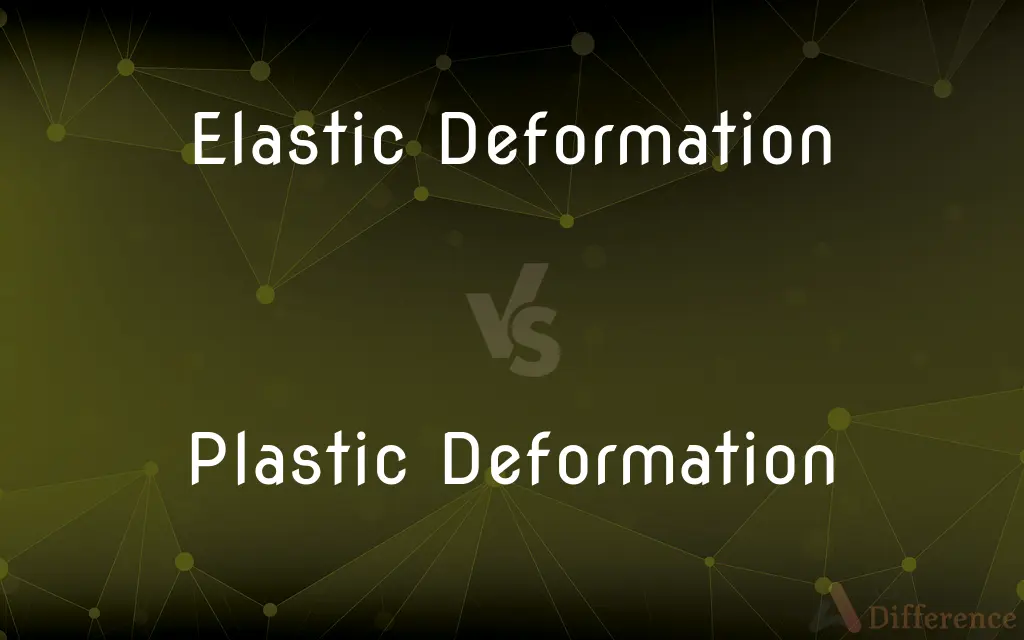Elastic Deformation vs. Plastic Deformation — What's the Difference?
Edited by Tayyaba Rehman — By Fiza Rafique — Published on December 9, 2023
Elastic Deformation is temporary change when stress is applied and removed, reverting to its original form, while Plastic Deformation is a permanent change maintaining the deformed shape even after stress removal.

Difference Between Elastic Deformation and Plastic Deformation
Table of Contents
ADVERTISEMENT
Key Differences
Elastic Deformation and Plastic Deformation, two fundamental concepts in materials science, address how materials change shape under stress. Elastic Deformation pertains to the temporary deformation of materials when subjected to a stress. This means when the stress is released, the material will return to its initial shape. Think of a spring being compressed; once you let go, it bounces back.
Plastic Deformation, on the other hand, represents the permanent change in shape when a material is stressed beyond its elastic limit. This deformation remains even after the stress is removed. To visualize this, imagine molding clay into a new shape; even if you stop applying force, the clay retains its new form.
The boundary between Elastic Deformation and Plastic Deformation is often termed the "yield point." Before this point, materials exhibit Elastic Deformation, springing back to their original shape post-stress. Beyond this point, they experience Plastic Deformation, maintaining their altered shape even after the removal of stress.
Factors like temperature and strain rate can influence both Elastic Deformation and Plastic Deformation. For instance, a metal might be more prone to Plastic Deformation at higher temperatures. Furthermore, while Elastic Deformation is reversible and energy-efficient, Plastic Deformation involves breaking and reforming of atomic bonds, making it an energy-consuming and irreversible process.
The practical implications of understanding Elastic Deformation and Plastic Deformation are vast, spanning industries from construction to manufacturing. Recognizing the limits and behaviors of materials under stress ensures the longevity, safety, and effectiveness of various products and structures.
ADVERTISEMENT
Comparison Chart
Reversibility
Reversible upon stress removal.
Irreversible even after stress removal.
Energy Consumption
Minimal; energy is stored and released.
More; energy is often dissipated.
Behavior under Stress
Material returns to its original shape.
Material retains its deformed shape.
Occurrence
Before the yield point.
After the yield point.
Structural Changes
Atomic or molecular structures remain intact.
Involves breaking and reforming of atomic or molecular bonds.
Compare with Definitions
Elastic Deformation
Elastic Deformation happens within the material's elastic limit.
Materials like steel show Elastic Deformation until they reach a certain stress threshold.
Plastic Deformation
Plastic Deformation occurs when stressed beyond the elastic limit.
Forging metals involves heating them to induce Plastic Deformation, shaping them permanently.
Elastic Deformation
In Elastic Deformation, materials revert to their original state post stress.
A compressed spring showcases Elastic Deformation as it returns to its initial shape once the force is gone.
Plastic Deformation
Plastic Deformation often dissipates energy, making it irreversible.
Flattening dough with a rolling pin results in Plastic Deformation, and the dough won't spring back to its initial shape.
Elastic Deformation
Elastic Deformation is the temporary change in shape under stress.
When a rubber band is stretched and then released, it undergoes Elastic Deformation.
Plastic Deformation
Plastic Deformation results in a permanent change in a material's shape.
When clay is molded, it displays Plastic Deformation, retaining its new form.
Elastic Deformation
Elastic Deformation stores energy which gets released upon stress removal.
Jumping on a trampoline involves Elastic Deformation, storing energy with each bounce and releasing it upon ascent
Plastic Deformation
Once a material undergoes Plastic Deformation, it won't return to its original state.
Bending a plastic ruler too far can cause Plastic Deformation, making it stay bent.
Elastic Deformation
No permanent atomic or molecular changes occur during Elastic Deformation.
When a sponge is pressed and then let go, its Elastic Deformation doesn't alter its molecular structure.
Plastic Deformation
Atomic or molecular bonds break and reform during Plastic Deformation.
Metal sheets rolled into tubes go through Plastic Deformation, changing their atomic arrangements.
Common Curiosities
What is plastic deformation?
Plastic deformation is a permanent change in the shape or size of an object due to applied stress, even after the stress is removed.
What happens to the bonds of materials during elastic deformation?
During elastic deformation, atomic bonds are stretched but not broken. They return to their original state once the stress is removed.
Is plastic deformation reversible?
No, plastic deformation is irreversible. The material does not return to its original shape or size after the stress is removed.
What's an example of elastic deformation in everyday life?
Stretching a rubber band and watching it return to its original size when released is an example of elastic deformation.
What is elastic deformation?
Elastic deformation is a temporary change in the shape or size of an object that disappears once the applied stress is removed.
What is Hooke's Law?
Hooke's Law states that the force needed to extend or compress a spring is proportional to the distance it is stretched or compressed, provided the elastic limit is not exceeded.
What happens to the bonds of materials during plastic deformation?
During plastic deformation, atomic bonds can break or rearrange, leading to a permanent change in the material's structure.
What's the significance of the elastic limit or yield point?
The elastic limit or yield point is the maximum stress a material can withstand without undergoing permanent plastic deformation.
How does strain hardening relate to plastic deformation?
Strain hardening, also known as work hardening, is the process by which a material becomes harder and stronger as it undergoes plastic deformation.
Is elastic deformation reversible?
Yes, elastic deformation is reversible. Once the applied stress is removed, the material returns to its original shape and size.
Are all materials subject to both types of deformation?
While most materials exhibit both elastic and plastic deformation under certain conditions, some materials, like perfectly brittle ones, might break before showing noticeable plastic deformation.
What's an example of plastic deformation in everyday life?
Bending a paperclip out of its original shape, and it staying in the new shape, is an example of plastic deformation.
How does temperature influence elastic and plastic deformation?
As temperature increases, materials generally become more ductile, decreasing their elastic limit and making them more prone to plastic deformation.
How can we measure or detect plastic deformation in a material?
Plastic deformation can be detected using methods like microscopy to observe changes in the material's microstructure or by noting permanent changes in the material's shape or dimensions after stress is removed.
Can plastic deformation be beneficial?
Yes, plastic deformation can be beneficial in processes like metal forging, where controlled deformation improves the material's mechanical properties.
Share Your Discovery

Previous Comparison
Structured Interview vs. Unstructured Interview
Next Comparison
Hashing vs. EncryptingAuthor Spotlight
Written by
Fiza RafiqueFiza Rafique is a skilled content writer at AskDifference.com, where she meticulously refines and enhances written pieces. Drawing from her vast editorial expertise, Fiza ensures clarity, accuracy, and precision in every article. Passionate about language, she continually seeks to elevate the quality of content for readers worldwide.
Edited by
Tayyaba RehmanTayyaba Rehman is a distinguished writer, currently serving as a primary contributor to askdifference.com. As a researcher in semantics and etymology, Tayyaba's passion for the complexity of languages and their distinctions has found a perfect home on the platform. Tayyaba delves into the intricacies of language, distinguishing between commonly confused words and phrases, thereby providing clarity for readers worldwide.













































